Portfolio
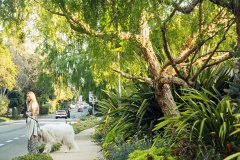
SAN YSIDRO ROAD SAFE ROUTES TO SCHOOL -
We created an attractively rural walking path to implement a "Safe Route to School" for people of all ages along San Ysidro Road. The plantings defining the path bloom throughout the year and require no water.
We created an attractively rural walking path to implement a "Safe Route to School" for people of all ages along San Ysidro Road. The plantings defining the path bloom throughout the year and require no water.
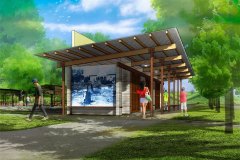
HOLLISTER KELLOGG GOLETA PARK -
Extensive community outreach and workshops shaped this park design. According to popular preference, recreational features were carefully designed into the plan, to include a multi-use playing field, group picnic, and bbq areas, play courts, skate plaza, fully accessible playground, bocce court, ping pong tables, fitness nodes, handball courts, piñata poles, and bike racks. Stormwater management and habitat restoration along San Jose Creek add a layer of sustainability to the project.
Extensive community outreach and workshops shaped this park design. According to popular preference, recreational features were carefully designed into the plan, to include a multi-use playing field, group picnic, and bbq areas, play courts, skate plaza, fully accessible playground, bocce court, ping pong tables, fitness nodes, handball courts, piñata poles, and bike racks. Stormwater management and habitat restoration along San Jose Creek add a layer of sustainability to the project.
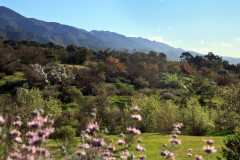
SHEFFIELD RESERVOIR -
A 40 million gallon open-air reservoir was replaced by two underground reservoirs with a new passive open space park above. Several trail systems were designed to emphasize important aspects of the open space such as the historic parapet wall of the reserve, a stone drainage channel built during the WPA era, and the awe-inspiring views of La Cumbre Peak and other local mountain tops.
A 40 million gallon open-air reservoir was replaced by two underground reservoirs with a new passive open space park above. Several trail systems were designed to emphasize important aspects of the open space such as the historic parapet wall of the reserve, a stone drainage channel built during the WPA era, and the awe-inspiring views of La Cumbre Peak and other local mountain tops.

CARPINTERIA SALT MARSH -
Vision:
To restore a wetland site to its native state; one which had previously been filled in and slated for development.
Creation:
We worked with ecologist Wayne Ferren to create an attractive, inviting interface between the newly created wildland habitat and the local community. To help people understand why wetlands are important, we stationed interpretive signage throughout a trail system that includes gathering areas, native plantings, an amphitheater, and an overlook.
Result:
By restoring the land, we were able to create a gathering place that is so beautiful that it is not uncommon to see people painting, meditating, practicing their qigong or yoga flow, and even getting married in the park. It is difficult not to feel inspired while walking on the vast trail system that twists around the surrounding nature. We were able to turn a landscape that was once destroyed back into its native state, even restoring its natural tidal flow, and creating a space where humans and wildlife can happily coexist.
Vision:
To restore a wetland site to its native state; one which had previously been filled in and slated for development.
Creation:
We worked with ecologist Wayne Ferren to create an attractive, inviting interface between the newly created wildland habitat and the local community. To help people understand why wetlands are important, we stationed interpretive signage throughout a trail system that includes gathering areas, native plantings, an amphitheater, and an overlook.
Result:
By restoring the land, we were able to create a gathering place that is so beautiful that it is not uncommon to see people painting, meditating, practicing their qigong or yoga flow, and even getting married in the park. It is difficult not to feel inspired while walking on the vast trail system that twists around the surrounding nature. We were able to turn a landscape that was once destroyed back into its native state, even restoring its natural tidal flow, and creating a space where humans and wildlife can happily coexist.
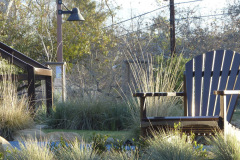
BOHNETT PARK -
The park creatively addresses a number of vital needs for the residents of a densely built out neighborhood, including open space to relieve the effects of crowded housing, improved safety, a unique visual identity expressed through art and architecture, access to a restored riparian environment, and pride for an often overlooked segment of the community. The imagery of the park combines indigenous flora and fauna, abstracted architecture, and fanciful art to provide a distinctive centerpiece for the neighborhood.
The view of, and access to, the creek restoration provides the neighborhood with a valuable connection to the natural environment. Proximity to the Boys and Girls Club and public housing projects provides an opportunity for at-risk youth to participate in educational programs resulting in an understanding of creeks and their important environmental role. The design elements of the park are based on the concept of a residence without walls, sitting on a typical Westside lot. This “bungalow” is situated in a garden with a tidy lawn, doghouse, over-sized lawn chairs, native California plantings, and a continuation of the boulder-lined creek meandering through the garden.
The park creatively addresses a number of vital needs for the residents of a densely built out neighborhood, including open space to relieve the effects of crowded housing, improved safety, a unique visual identity expressed through art and architecture, access to a restored riparian environment, and pride for an often overlooked segment of the community. The imagery of the park combines indigenous flora and fauna, abstracted architecture, and fanciful art to provide a distinctive centerpiece for the neighborhood.
The view of, and access to, the creek restoration provides the neighborhood with a valuable connection to the natural environment. Proximity to the Boys and Girls Club and public housing projects provides an opportunity for at-risk youth to participate in educational programs resulting in an understanding of creeks and their important environmental role. The design elements of the park are based on the concept of a residence without walls, sitting on a typical Westside lot. This “bungalow” is situated in a garden with a tidy lawn, doghouse, over-sized lawn chairs, native California plantings, and a continuation of the boulder-lined creek meandering through the garden.

CLUFF VISTA PARK -
Cluff Vista Park is a little piece of nature right in the city of Ojai. Through a series of community meetings, Van Atta Associates and Ojai landscape architect Tom Bostrum worked together to create an oasis of themed California native gardens, including a hummingbird garden, a butterfly garden, a deer grass meadow, and a sage scented garden.
The effect of the blazing Ojai sun is minimized by vine-covered, shady arbors and by soothing water, which flows from an origin fountain to a waterfall and into a riparian plant community. This pocket-sized gem of a park is especially beautiful at sunset with its spectacular views of the Topa Topa mountains during their famous “pink moment.”
Cluff Vista Park is a little piece of nature right in the city of Ojai. Through a series of community meetings, Van Atta Associates and Ojai landscape architect Tom Bostrum worked together to create an oasis of themed California native gardens, including a hummingbird garden, a butterfly garden, a deer grass meadow, and a sage scented garden.
The effect of the blazing Ojai sun is minimized by vine-covered, shady arbors and by soothing water, which flows from an origin fountain to a waterfall and into a riparian plant community. This pocket-sized gem of a park is especially beautiful at sunset with its spectacular views of the Topa Topa mountains during their famous “pink moment.”
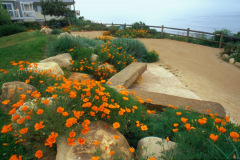
PELICAN PARK -
Working with the Isla Vista Recreation and Parks District, we turned this one-acre bluff-top site into an inviting space for recreation and relaxation amid the bustle of campus life. Pelicans fly by practically at eye level across views across the water of the Channel Islands.
Plants that are native to the islands, including a meadow of ferny yarrow (instead of a lawn), are used throughout the landscape, which also includes drinking fountains, stone couches (gently bermed into the meadow), picnic tables, and even a ping pong table, all constructed from terrazzo. Whether as a place to study, lounge, procrastinate, or enjoy the amazing sunsets, this park is truly prized by its community.
Working with the Isla Vista Recreation and Parks District, we turned this one-acre bluff-top site into an inviting space for recreation and relaxation amid the bustle of campus life. Pelicans fly by practically at eye level across views across the water of the Channel Islands.
Plants that are native to the islands, including a meadow of ferny yarrow (instead of a lawn), are used throughout the landscape, which also includes drinking fountains, stone couches (gently bermed into the meadow), picnic tables, and even a ping pong table, all constructed from terrazzo. Whether as a place to study, lounge, procrastinate, or enjoy the amazing sunsets, this park is truly prized by its community.

TOMOL INTERPRETIVE PLAY AREA -
This park is a manifestation of the Chumash legend of the Rainbow Bridge. Most elements in the play area are tied to Chumash culture and Carpinteria’s natural resources. Because the legend includes Santa Cruz island, the Santa Ynez mountains behind Carpinteria, and the Santa Barbara Channel, all of these topographic elements are represented in the project.
A pathway bridge that serves to connect the island to the mainland is included. Asphaltum, naturally occurring in abundance in Carpinteria was used by Chumash culture to waterproof their baskets and tools, and so Van Atta Associates included an asphalt cliff feature that serves as a small amphitheater. Two sweat-houses and an "ap" mimic a Chumash village and serve as climbing structures. A full-sized tomol is "beached" nearby, allowing children to imagine themselves on the shoreline looking out to sea where dolphins have been positioned to play their part in the rainbow bridge interpretation.
This park is a manifestation of the Chumash legend of the Rainbow Bridge. Most elements in the play area are tied to Chumash culture and Carpinteria’s natural resources. Because the legend includes Santa Cruz island, the Santa Ynez mountains behind Carpinteria, and the Santa Barbara Channel, all of these topographic elements are represented in the project.
A pathway bridge that serves to connect the island to the mainland is included. Asphaltum, naturally occurring in abundance in Carpinteria was used by Chumash culture to waterproof their baskets and tools, and so Van Atta Associates included an asphalt cliff feature that serves as a small amphitheater. Two sweat-houses and an "ap" mimic a Chumash village and serve as climbing structures. A full-sized tomol is "beached" nearby, allowing children to imagine themselves on the shoreline looking out to sea where dolphins have been positioned to play their part in the rainbow bridge interpretation.
